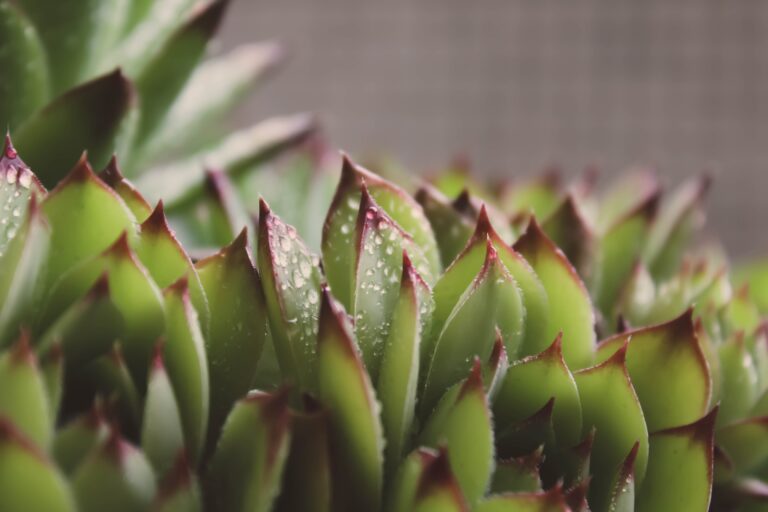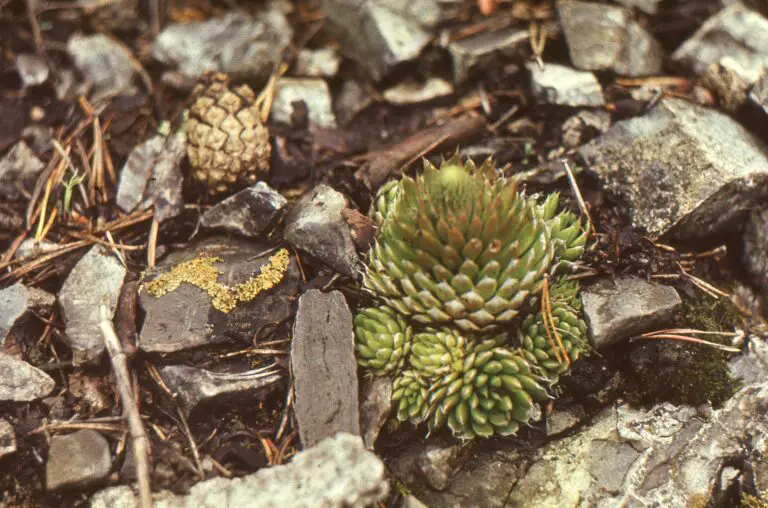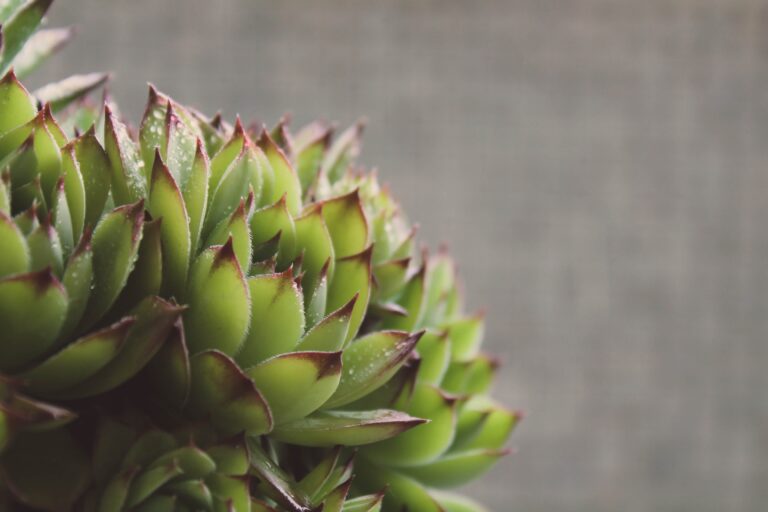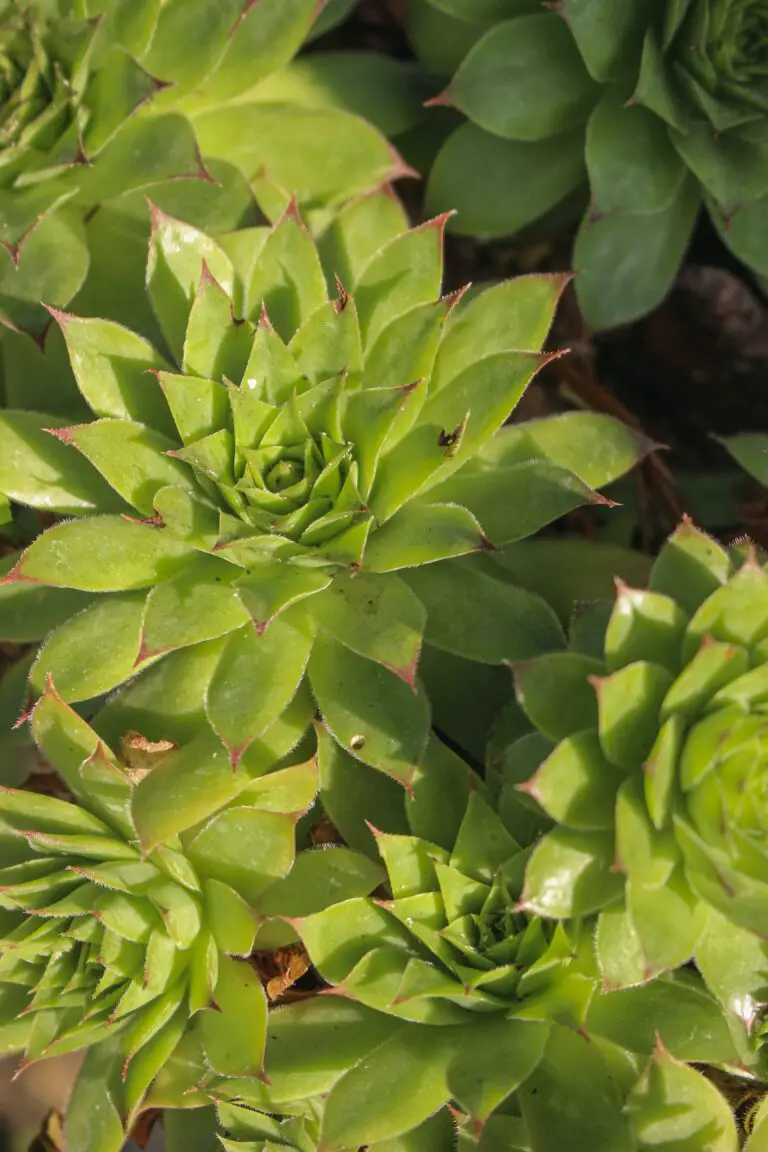Introduction to Sempervivum Arachnoideum
Welcome to the world of Sempervivum arachnoideum, affectionately dubbed the Cobweb Hen and Chick. This peculiar plant, with its spiderweb-like adornments, captures the imagination and beckons a closer look into its origin story and natural abode. Where does this living artwork come from, you ask? Tucked away in the nooks of the European mountains, this succulent thrives, finding solace in the craggy landscape that many would deem inhospitable.
As if spun by fairytale creatures, the cobweb patterns that overlay its robust rosettes are not only a marvel to behold but also serve a practical purpose. They shield the plant from the intense high-altitude sun and conserve precious moisture, a testament to nature’s engineering. Yet, despite its delicate appearance, Sempervivum arachnoideum is a warrior, weathering the extremes of its mountainous terrain with grace.

What truly sets this succulent apart? Is it the tenacity with which it anchors itself amongst the rocks, or perhaps its enchanting, velvet-like texture that challenges the norm of a rugged landscape? To behold a cluster is to observe a masterclass in survival, as these plants live communally, supporting one another against the elements—thus earning the name ‘Hen and Chicks’. The ‘hen’ or mother plant spawns ‘chicks’, creating a self-sustaining colony that evolves and thrives through the ages.
The beauty of Sempervivum arachnoideum extends beyond its visual charm; it’s a plant that teaches resilience and adaptation. Gardeners and nature enthusiasts alike find joy in tending to these robust specimens, often marveling at their ability to bloom even when uprooted and replanted in foreign soils. Dive into our guide on succulent care to discover how you can nurture these and other resilient species for a touch of alpine wonder in your own space.
It is this remarkable durability and uniqueness that makes the Cobweb Hen and Chick a treasure worth uncovering. It’s not just a plant; it’s a story of endurance, a living symbol of nature’s tenacious grip on life—even in the face of towering odds. So next time you glance at these green rosettes nestled in your palm or flourishing in your garden, remember the mountains they’ve conquered to reach you.
The Botanical Profile of Cobweb Houseleek
Imagine setting foot in a lush, verdant garden, where each step uncovers a new botanical marvel. Among these, you stumble upon an absolute treat for the eyes—Sempervivum Arachnoideum. Yes, the Cobweb Houseleek, Nature’s own enchanting velvet carpet, a succulent that sweeps you off your feet with its unique beauty. This marvel signals both resilience and elegance as it thrives in the craggy embraces of the European mountains.
What sets the Sempervivum Arachnoideum apart from its succulent kin is its distinctive cobweb-like features. Peer closely and you’ll witness a spectacle of tiny filaments, akin to a spider’s delicate web, that cloak the tips of its leaves. These cobwebbed rosettes are not just a peculiar sight to behold; they’re a testament to this plant’s adaptability, protecting its precious water stores from parched mountain breezes.

Each rosette, a symmetrical masterpiece of nature, is an intricate assembly deftly crafted from fleshly, vibrant leaves. These leaves hold life-giving water, allowing the plant to flaunt its verdure even when the skies withhold mercy. The hues of green are so intense that they can easily be described as botanic emeralds nestling on the rocky outcrops of their high-altitude homes.
A curious mind yearning for botanical wisdom, might find a comprehensive understanding of the care required by these captivating plants. Misconstrued often as needy, they are, in fact, a gardener’s dream for their minimal requirements and otherworldly appeal. Enrich your knowledge, and soon you might be weaving stories about these cobweb-covered jewels embellishing your own garden scape.
But our journey does not end at admiration. On the pages dedicated to succulent care, one uncovers the art of nurturing these robust yet regal plants. It is here that Sempervivum Arachnoideum finds its echo, among peers that share its resilience and thirst for life.
Dive into the science behind its formation, understand the rationale for its habitats, and marvel at how such delicate beauty prospers amidst the alpine harshness. As the Cobweb Houseleek weaves its narrative of survival and splendor, let it remind us of the incredible tapestry of life that thrives in every corner of our planet. Nature, indeed, has crafted a velvety masterpiece in Sempervivum Arachnoideum.
Ideal Growing Conditions for Sempervivum Arachnoideum
Have you ever wondered what it takes for the Sempervivum arachnoideum, also known as the cobweb houseleek, to flaunt its plush rosettes? It’s much easier than you might think! These alpine treasures are both hardy and forgiving, making them perfect for novice gardeners or those with a forgetful watering hand. So, let’s set the stage for these beauties to thrive.
Soiling the Canvas: Crafting the Perfect Foundation
Imagine crafting a masterpiece on a velvet canvas – that’s your Sempervivum arachnoideum. But first, the foundation must be impeccable. The ideal soil for our cobwebby friends is well-draining and gritty. Picture a mix of sharp sand, perlite, and potting soil, as airy as a mountain breeze. This perfect mix allows water to stream through like a clear brook, avoiding dreaded root rot. It’s like putting your plants on a high pedestal, well-deserved for green royalty.
Let There Be (Bright) Light!
These succulents adore the spotlight, basking in full sun or part shade. Imagine a sun-kissed balcony or a bright garden spot that mimics their natural high-altitude homes. They enjoy long hours of sunlight, weaving their weblike beauty with each golden ray. Those who dwell in cloudier realms need not worry, though. A south-facing window or a lively conservatory can be just as inviting for these sun-worshipping specimens.
A Chill in the Air: Cooler Temperatures for a Hardy Outlook
Unlike tropical cousins that prefer the warmth, Sempervivum arachnoideum is the rugged mountaineer of succulents. It flourishes best in cooler conditions, even during the warmth of summer. As the temperature drops at night, it tightens its rosettes, as if snuggling under a cobweb duvet. For those living in a warmer climate, providing some afternoon shade can mimic this cooling effect and keep your succulents hoarfrosty-fringed and fabulous.
Get ready to be amazed by the resilience of these succulents as they brave the elements. If you’re curious about how far their toughness extends, take a peek at this informative video:
And for those who are eager to expand their succulent savviness, explore our ultimate guide to succulent care. It’s a treasury of tips and tricks that will help you create a lush, vibrant haven for your green companions!
Propagation and Cultivation Tips
Ever dreamt of creating your own luscious landscape with the enigmatic Sempervivum arachnoideum? Now’s your chance to turn that green dream into a verdant reality! Let’s dive into the art of propagating and cultivating these fascinating plants. Picture your garden as a painter’s canvas, where each rosette of Sempervivum arachnoideum adds a unique stroke to your masterpiece.
Begin with the Basics: Like any good tale, propagation starts at the beginning. Have you ever noticed those charming little offsets, or “pups,” that sprout around the mother plant? These are your ticket to multiplication! Gently separate these pups when they have a few roots of their own, ensuring each has a piece of the living legacy to thrive upon. There’s no need to rush; patience pays off with stronger, independent rosettes ready to conquer their own pots.
Perfecting the Potting: Next up, let’s talk terrain. Sempervivum arachnoideum thrives in well-draining soil – think of an alpine mountainside, rugged and rocky. Mimic this environment with a special succulent mix or create your own with equal parts soil, sand, and perlite. Your Serengeti of succulents deserves nothing less than the prime real estate of gritty goodness.
Want to see it in action? Here’s a video that virtually walks you through the propagation process, showcasing just how simple spreading the succulent love can be.
The Watering Whims: When it comes to hydration, these are not your average thirst-quenchers. Overwatering invites rot, so let the soil dry out between watering sessions. Imagine if rain boots were compulsory every day; your feet would protest! Give them a drink, but allow them to savor it, drying their roots before the next watering waltz.
I recall a friend who nurtured a Sempervivum from a single rosette to a dazzling display of dew-kissed velvet. He heeded the watering wisdom diligently, using the soak and dry method to perfection. His success wasn’t due to a mysterious green thumb – he simply understood the drink-dry-repeat rhythm essential to these plants.
Light and Location: As for sunlight, Sempervivum arachnoideum is solar-powered, craving those golden rays like a cat basking in a sunbeam. However, they don’t require a scorching desert sunscape to prosper. Aim for a cozy sunbath spot that welcomes them with warmth, not a harsh burn. A good rule of paw – if a cat would lounge there, it’s perfect for your sempervivum.
And there you have it – propagation and cultivation tips that promise a luscious garden brimming with life. Remember, like a good story, each plant has its own narrative arc. Nurture them, learn from them, and watch as your garden becomes a living storybook, with each sempervivum a character in its own verdant tale.
For more information on general succulent care and to ensure your newly propagated Sempervivum arachnoideum gets all it needs, check out these additional care tips. With a little insight and the right approach, you’ll have happy, hearty succulents adorning your space.
Common Challenges and Solutions in Caring for Sempervivum Arachnoideum
When you embrace the world of gardening, bringing a Sempervivum Arachnoideum into your home can be like unrolling a natural velvet carpet, vibrant and velvety to the touch. Yet, this succulent treasure is not without its trials. Vigilance is key to keeping your green gem gleaming and unblemished.

True foes of Sempervivum Arachnoideum often come in tiny packages, with pests like aphids and spider mites treating your plant like a personal buffet. Diseases, too, can strike—root rot and fungal ailments wait for any opening to invade. But fret not; these challenges have solutions as robust as the plant itself.
The Pesty Predicament: Aphids and Spider Mites
Your Sempervivum Arachnoideum is a hearty species, but it can still fall prey to the insistent nibbling of aphids and the stealthy advances of spider mites. These pests are surreptitious invaders, often remaining unnoticed until they’ve formed an army. Regular inspections are crucial—gently turn the leaves and peek into the rosette’s embrace, where these critters like to hide. Upon discovery, a simple spray of neem oil or insecticidal soap can send them packing. For a touch of nature’s own warfare, consider introducing natural predators such as ladybugs into your garden ecosystem.
Undesirable Residents: Root Rot and Fungal Issues
Root rot and fungal diseases are the bane of many succulent enthusiasts. The root of the problem is often poor drainage or overwatering. Imagine your roots gasping for air as they drown in soggy soil—it’s a silent scream for better care. Adjust your watering routine, ensuring that the soil dries out between drinks. A mix of sandy or gravelly soil will give those roots the oxygen they crave and keep fungal foes at bay. Should the dreaded rot still take hold, swift action to remove affected parts and repot the plant can salvage your velvet beauty.
With attentive care and timely intervention, your Sempervivum Arachnoideum will thrive, continuing to unfurl its lush, spider-webbed rosettes. Armed with knowledge and a watchful eye, you can preempt the whisper of wings or the shadow of decay, ensuring your velvet carpet remains ever green and glorious.
Designing Gardens with Sempervivum Arachnoideum
Create visually appealing landscapes by incorporating Sempervivum arachnoideum into rock gardens, green roofs, and other garden designs. Known for its intricate web-like structures and robust nature, this succulent is not just a plant—it’s a statement of resilience and beauty. Plus, it’s an excellent conversation starter! Imagine having friends over and their fascination when you tell them about these velvet-like green cushions that can survive the harshest of weathers.

Picture this: you’re meandering through a serene rock garden, and you stumble upon clusters of sempervivum arachnoideum nestled among the stones. These artistic rosettes bring a tapestry of deep reds and fresh greens to the garden, and with each passing season, they spread to fill the spaces with lush, low-maintenance splendor. Such an installation is not only aesthetically pleasing but also environmentally conscious, asking for very little yet giving so much in return.
By blending sempervivum arachnoideum into your green roof projects, you enlist nature’s little architects to transform bland spaces into vibrant ecosystems. They are remarkable insulators, offering a natural cooling effect in summer and an extra layer of warmth during winter. It’s a sustainable choice that also enhances biodiversity as the roof becomes a refuge for beneficial insects and birds.
Today, more than ever, we seek to bring nature closer, and what better way than to incorporate these natural jewels into your garden design. Whether it’s the façade of a commercial building or the pot on your balcony, sempervivum arachnoideum provides a low-cost, high-impact design element that’s adaptable, hardy, and endlessly fascinating. Now, that’s what we call smart gardening!
Conserving the Sempervivum Arachnoideum Ecosystem
Picture this: a landscape where every crevice is majestically woven with a blanket of velvety greens and blooms, a habitat so unique, it captures the essence of biodiversity. This is where Sempervivum arachnoideum, or the cobweb houseleek, casts its ecological spell.
Despite its small size, Sempervivum arachnoideum leaps into the heroic role of ecosystem engineer. Born to survive in the harshest alpine climates, this succulent not only clings to life but supports a web of other organisms. It’s not just a plant; it’s a cornerstone for diverse alpine life.
The Web of Life Starring Sempervivum Arachnoideum
Take a moment to reflect on the spiral of interactions occasioned by this hardy plant species. Bees dizzily buzz from flower to flower, carrying pollen that ensures the diversity of the ecosystem. Microbes, snug in the lush green rosettes, break down organic matter, enriching the soil. Each cobweb-patterned leaf holds droplets of water, a precious resource that sustains life on the rocky slopes.
Highlighting the plant’s indomitable spirit, consider the real-life endurance of sempervivums during a parched summer. Resilient against drought, they provide critical moisture for other plants and insects. It is not just about their survival; it’s about maintaining the balance for the entire alpine biosphere.

Imagine losing sight of such an organism from our alpine landscapes; we’d risk toppling a domino of biodiversity. The protection of Sempervivum arachnoideum is, therefore, not just the conservation of a species, but the safeguarding of an entire ecosystem woven intricately through its existence.
So when we talk about conserving the Sempervivum arachnoideum ecosystem, we are dipping our toes into the vast ocean of ecological preservation. It is a call to action to all nature enthusiasts and conservationists to preserve the intricate web of life, starting with the cobweb houseleek tapestries gracing our majestic mountains.
Frequently Asked Questions
So, you’ve laid eyes on the Sempervivum arachnoideum, have you? This intriguing little succulent, also known in hushed tones as the Cobweb Houseleek, is famous for its artful rosettes woven with fine webbing just like an arachnid’s masterpiece. Whether you’re a seasoned green thumb or new to the houseplant hustle, you probably have questions swarming in your mind about how to nurture this velvety gem. Let’s dive into the dirt, shall we?
How Do I Keep My Sempervivum Arachnoideum Thriving?
First things first: location, location, location. These succulents are alpine stars, which means they love basking in full sun or partial shade. But don’t think they need pampering; in fact, think of them as the Spartans of the plant world—tough, resilient, and stunning under pressure. Pop them in a spot that gets plenty of light, and they’ll reward you with vigorous growth and vibrant colors.
What’s the Ideal Watering Ritual for This Succulent?
Here’s the scoop: overwatering is the kiss of death for our Sempervivum friends. They thrive on neglect, like that one enigmatic friend who somehow looks fabulous without trying. To keep them looking their best, water deeply but infrequently, allowing the soil to dry out between drinks. Picture a desert downpour followed by endless blue skies—that’s the rhythm you want.
Catch a glimpse of the Sempervivum Arachnoideum care ritual right here:
Propagation: How Can I Multiply My Velvet Carpet?
Now, who wouldn’t want more of these beauties? Propagation is a breeze with Sempervivum arachnoideum. You’ll notice little offsets, or “chicks,” budding off from the mother “hen.” Gently tease these babies apart and replant them in a similar cactus mix. It’s like creating a family tree, but with more photosynthesis and less awkward family reunions.
Are There Any Pests to Watch Out For?
Even the mightiest heroes have their weaknesses, and for our velvet carpet, it’s the occasional aphid or mealybug looking to crash the party. Keep an eye out for uninvited guests and escort them out with a strong jet of water or an insecticidal soap meant for succulents. Remember, only you can prevent plant pandemonium.
What Kind of Soil Mix Does My Sempervivum Need?
Imagine your succulent’s roots in a pair of breathable running shoes—that’s what a well-draining soil mix feels like to them. A blend of potting soil with sand or perlite will give your Sempervivum arachnoideum the airy home it craves. And don’t skimp on the container, either—a pot with a drainage hole is a non-negotiable luxury here.
With these tidbits, your Sempervivum arachnoideum will be more than just a living decoration; it’ll be a testament to your gardening prowess. Embrace the FAQs, for they pave the path to green-fingered glory!
